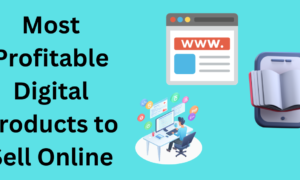Looking to start an online business but don’t want the hassle of stocking inventory? Well, you’re in luck! In this digital age, there are countless ways to sell products without ever having to touch or store them. Say goodbye to boxes cluttering up your living room and hello to a streamlined and efficient way of doing business. Whether it’s dropshipping, print-on-demand, or affiliate marketing, we’ve got you covered with seven surefire methods for selling online without the burden of inventory. So sit back, relax, and let us show you how to turn your entrepreneurial dreams into a reality!
What is Inventory?
Inventory refers to the stock of products that a business holds for sale. It includes everything from physical goods like clothing, electronics, or home decor items, to digital products like e-books or online courses. Essentially, it’s the tangible or intangible assets that a company invests in with the hope of making a profit.
Traditionally, selling with inventory meant purchasing bulk quantities of merchandise upfront and storing them until they were sold. This involved significant costs such as storage space, packaging materials, and shipping logistics. Not to mention the risk of being left with unsold items if market demand shifted unexpectedly.
However, thanks to advancements in technology and changes in consumer behavior, entrepreneurs now have alternatives that allow them to sell online without having to deal with inventory management headaches.
One popular method is dropshipping. With dropshipping, you act as the middleman between customers and suppliers. When an order is placed on your website or online store platform, you simply forward it to the supplier who then ships the product directly to your customer’s doorstep.
Another option is print-on-demand services where you partner with printing companies that handle production and shipping when an item is ordered through your website. This eliminates upfront costs associated with producing large quantities of merchandise since each item is custom-made only after it has been purchased by a customer.
Affiliate marketing takes another approach by allowing individuals or businesses (affiliates) to earn commission by promoting other people’s products on their websites or social media channels. When someone makes a purchase through their unique affiliate link, they receive a percentage of the sale without ever handling any inventory themselves.
These innovative methods offer flexibility and convenience for aspiring entrepreneurs looking for low-risk ways to enter into e-commerce without investing heavily in inventory upfront. While there are certainly pros and cons associated with each approach – which we’ll discuss later – these options have revolutionized how we do business online today.
The Traditional Way of Selling with Inventory
In the traditional way of selling, businesses would typically purchase inventory upfront and store it in warehouses or physical stores. This meant investing a significant amount of money into purchasing products before they were even sold.
Having inventory on hand allowed businesses to control their supply chain and fulfill customer orders quickly. However, it also came with its challenges. Businesses had to deal with the cost of storing inventory, managing stock levels, and the risk of having unsold items taking up valuable space.
Furthermore, there was always a risk of overstocking or understocking certain products, which could lead to lost sales or excess inventory that needed to be discounted or disposed of.
While the traditional method provided businesses with control over their product availability, it also required substantial financial investments and added complexities in managing inventory levels effectively.
The Rise of Dropshipping
The traditional way of selling with inventory has long been the norm for businesses. However, in recent years, a new method has emerged and is rapidly gaining popularity – dropshipping.
Dropshipping is a business model that allows entrepreneurs to sell products online without the need for physical inventory. Instead of purchasing and storing products themselves, they simply partner with suppliers or wholesalers who handle the storage and shipment of the products directly to customers.
This rise in dropshipping can be attributed to several factors. One key factor is the advancement of technology and e-commerce platforms that make it easier than ever before to set up an online store. With just a few clicks, anyone can create their own website or utilize existing marketplaces like Shopify or Amazon.
Another factor is the low barrier to entry. Unlike traditional retail where substantial capital investment is required upfront for inventory, dropshipping allows entrepreneurs to start their businesses with minimal financial risk. This makes it an attractive option for those looking to venture into entrepreneurship without significant funds.
Furthermore, dropshipping offers flexibility and scalability. Since there’s no need to manage inventory or worry about shipping logistics, sellers have more time and resources available to focus on marketing efforts and growing their business. They can easily add new products or expand into different niches without any additional burden or costs.
However, as with any business model, there are pros and cons associated with dropshipping. On one hand, it offers convenience and cost savings; on the other hand, sellers may have less control over product quality or shipping times since they rely on third-party suppliers.
In conclusion (as you requested), while traditional retailing still has its place in the market, it’s clear that dropshipping is on the rise due to its many advantages for online sellers. Whether you’re a budding entrepreneur looking for a low-risk opportunity or an established retailer wanting to diversify your offerings, exploring this innovative business model could be worth considering!
How Dropshipping Works
Dropshipping is a business model that allows entrepreneurs to sell products without having to carry inventory. Instead, the store owner purchases inventory as needed from a third party – usually a wholesaler or manufacturer – who then fulfills the order and ships it directly to the customer’s doorstep.
Here’s how dropshipping works in a nutshell:
1. Set up an online store: Choose your niche, create your website, and set up an e-commerce platform like Shopify or WooCommerce.
2. Source products: Find suppliers who offer dropshipping services and select the products you want to sell in your store.
3. List products on your website: Add product descriptions, images, and pricing information to entice customers.
4. Market your store: Use various marketing strategies like social media advertising, content marketing, or influencer partnerships to drive traffic to your site.
5. Receive orders: When a customer places an order on your website, you collect payment for the product at retail price.
6. Forward order details to the supplier: Once you receive payment from the customer, forward their shipping information and order details to the supplier for fulfillment.
7. Supplier ships directly to the customer: The supplier packages and ships out the product directly to the customer using their own packaging materials with no mention of themselves being involved in dropshipping.
The beauty of dropshipping lies in its simplicity – you don’t have any upfront costs associated with inventory storage or fulfillment logistics since everything is handled by someone else! However, it’s important to note that while dropshipping offers many advantages such as low startup costs and flexibility- there are also drawbacks like lower profit margins compared with traditional retail models.
Pros and Cons of Dropshipping
Dropshipping has gained popularity among online entrepreneurs for its numerous advantages, but like any business model, it also comes with its fair share of drawbacks. Let’s explore the pros and cons of dropshipping to help you make an informed decision.
One of the biggest advantages of dropshipping is that you don’t need to invest in inventory upfront. This eliminates the risk of holding excess stock or dealing with dead inventory. With dropshipping, you only purchase products from your suppliers when a customer places an order.
Another benefit is that dropshipping allows you to run your business from anywhere in the world. As long as you have a reliable internet connection, you can manage your store and fulfill orders without being tied down to a physical location.
Additionally, dropshipping offers a wide variety of products to choose from. You can easily add new items or remove underperforming ones without worrying about managing stock levels yourself.
On the downside, profit margins in dropshipping tend to be lower compared to traditional retail models. Since there are no bulk purchasing discounts available for individual orders, it can be challenging to compete on price alone.
Another drawback is that you have less control over product quality and shipping times since these aspects are handled by your suppliers. Any mistakes made by them could reflect poorly on your business reputation.
Because dropshipping requires relying on third-party suppliers for fulfillment, there may be issues with out-of-stock items or backorders which could lead to unhappy customers if not managed properly.
In conclusion, Dropshipping offers several advantages such as low startup costs and flexibility but also presents challenges like lower profit margins and lack of control over certain aspects. It’s important for aspiring entrepreneurs considering this model to carefully weigh these pros and cons before diving into the world of online retail without inventory
Other Ways to Sell Online Without Inventory
1. Print-on-Demand: With print-on-demand services, you can create and sell custom-designed products without any upfront costs or inventory. Simply upload your design, choose the products you want to offer (such as t-shirts or mugs), and when a customer places an order, the item is printed and shipped directly from the printing company.
2. Affiliate Marketing: As an affiliate marketer, you don’t need to worry about inventory or shipping. Instead, you earn a commission by promoting other people’s products on your website or social media platforms. When someone clicks on your affiliate link and makes a purchase, you receive a percentage of that sale.
3. Digital Products: Selling digital products like e-books, online courses, software, or music downloads is another way to generate income without keeping physical inventory. These items can be easily created once and sold repeatedly with no additional production costs.
4. Drop Servicing: Similar to dropshipping but for services instead of physical goods – drop servicing allows entrepreneurs to offer services they don’t personally provide themselves but outsource them instead. You act as the middleman between clients in need of specific services and freelancers who are skilled in those areas.
5. Subscription Box Business: By curating themed subscription boxes filled with unique items every month, you can create an ongoing revenue stream without managing traditional inventory levels constantly.
6. Virtual Events & Webinars: Hosting virtual events such as webinars or online conferences eliminates the need for physical space while still offering valuable content and networking opportunities for participants.
7. Social Media Influencer Brands Collaboration : Collaborating with social media influencers who have established brands allows individuals/businesses selling their own brand onto their influencer channel/platform making it easier for reaching target audiences.
These are just a few examples of how entrepreneurs can sell online without needing traditional inventory management systems in place! By leveraging these methods creatively , anyone can start an online business and generate income without the hassle of handling physical products.
Tips for Success in Selling Without Inventory
1. Choose the Right Products: When selling without inventory, it’s crucial to select products that are popular and have a high demand. Do market research to identify trending items or niche products that will attract customers.
2. Build Strong Supplier Relationships: Since you’ll be relying on suppliers for product fulfillment, it’s important to establish strong relationships with them. Communicate regularly, negotiate pricing terms, and ensure they meet your quality standards.
3. Optimize Your Online Store: Invest time in creating an appealing and user-friendly website that showcases your products effectively. Use high-quality images, detailed product descriptions, and customer reviews to build trust with potential buyers.
4. Implement Effective Marketing Strategies: Without physical inventory to showcase, you need to focus on marketing techniques that drive traffic and generate sales. Utilize social media platforms, email marketing campaigns, influencer partnerships, and SEO strategies to increase visibility.
5. Provide Excellent Customer Service: Differentiate yourself from competitors by offering exceptional customer service. Respond promptly to inquiries or issues raised by customers; this builds trust and fosters loyalty.
6. Monitor Inventory Levels of Suppliers: Stay vigilant about monitoring your supplier’s inventory levels so you can avoid selling out-of-stock items or dealing with delayed shipments.
7. Continuously Adapt and Improve: The online marketplace is ever-changing; therefore adaptability is key for success when selling without inventory. Stay up-to-date with the latest trends in e-commerce,
and be open-minded enough to adjust your business strategy accordingly.
Remember, selling without inventory requires careful planning, consistent effort, and effective execution.
By following these tips, you’ll increase the chances of achieving success in this dynamic online business model.
Conclusion
Selling online without inventory has become increasingly popular, thanks to the rise of dropshipping and other innovative methods. While traditional selling with inventory can be time-consuming and costly, these alternative approaches offer flexibility and reduced risk.
Dropshipping allows you to work directly with suppliers who handle storage, packaging, and shipping on your behalf. This means you can focus on marketing and customer service instead of managing stock levels. However, it’s important to consider the pros and cons before diving into this business model.
Additionally, there are other ways to sell online without inventory. You can explore options like print-on-demand services for custom products or affiliate marketing where you earn a commission for promoting others’ products. These alternatives give you more freedom in choosing what to sell and eliminate the need for upfront investment in physical goods.
To succeed in selling without inventory, it’s crucial to conduct thorough market research, choose reliable suppliers or partners, optimize your website for search engines (SEO), provide excellent customer service, and continuously adapt your strategies based on feedback from customers.
In conclusion, selling online without inventory opens up endless possibilities for entrepreneurs looking to start an e-commerce business with minimal risks. Whether through dropshipping or other creative solutions like print-on-demand or affiliate marketing, this approach offers convenience while focusing on core aspects such as marketing and customer experience.
So why wait? Embrace these innovative methods today! Start exploring the exciting world of e-commerce without being burdened by excessive inventory management – success is just a few clicks away!



























